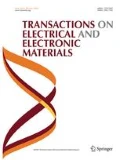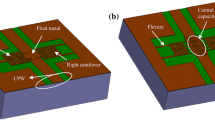Abstract
Radio frequency micro-electro-mechanical system (RF MEMS) switch is basic component for transponders used in communication system. Switch “OFF/ON” capacitance ratio plays major role in controlling signal to noise ratio. Theoretically, with high dielectric constant material or floating metal concept, capacitance ratio can be improved up to 2000 or even more. Whereas, in most of the practical cases, measured ratio is less than 200. In present paper, RF MEMS capacitive switch LCR parameters are extracted considering parasitic capacitance to explain the mismatch of measured results. Parasitic capacitance is independent from device overlap area. Parasitic capacitance is function of switch geometry and directly proportional to dielectric constant of the substrate material.





Similar content being viewed by others
References
K. Najafi, Micropackaging technologies for integrated microsystems: applications to MEMS and MOEMS. Proc. SPIE 4979, 1–19 (2003)
C. Goldsmith, D. Forehand, D. Scarbrough, Z. Peng, C. Palego, J. Hwang, J. Clevenger, Understanding and improving longevity in RF MEMS capacitive switches. Proc. SPIE 6884, 688403–688403-12 (2008)
D. Bansal, A. Bajpai, P. Kumar, M. Kaur, K. Rangra, Fabrication and analysis of radiofrequency MEMS series capacitive single-pole double-throw switch. J. Micro/Nanolithography, MEMS, MOEMS 15(4), 045001 (2016)
A.Q. Liu, W. Palei, M. Tang, A. Alphones, Single-pole-four-throw switch using high-aspect-ratio lateral switches. Electron. Lett. 40(18), 1125 (2004)
J. Iannacci, M. Huhn, C. Tschoban, H. Pötter, RF-MEMS technology for future (5G) mobile and high-frequency applications: reconfigurable 8-bit power attenuator tested up to 110 GHz. IEEE Electron Device Lett. 37(12), 1646–1649 (2016)
Z.J. Guo, N.E. McGruer, G.G. Adams, Modeling, simulation and measurement of the dynamic performance of an ohmic contact, electrostatically actuated RF MEMS switch. J. Micromech. Microeng. 17(9), 1899–1909 (2007)
A.S. Khan, T. Shanmuganantham, Design and analysis of RF MEMS cantilever switches for parameter enhancement. Trans. Electr. Electron. Mater. 0123456789, 1–9 (2018)
D. Bansal, A. Kumar, A. Sharma, P. Kumar, K.J. Rangra, Design of novel compact anti-stiction and low insertion loss RF MEMS switch. Microsyst. Technol. 20(2), 337–340 (2013)
D. Bansal, A. Bajpai, P. Kumar, A. Kumar, M. Kaur, K. Rangra, Design and fabrication of a reduced stiction radio frequency MEMS switch. J. Micro/Nanolithography, MEMS, MOEMS 14(3), 035002 (2015)
C.D. Patel, G.M. Rebeiz, A compact RF MEMS metal-contact switch and switching networks. IEEE Microw. Wirel. Compon. Lett. 22(12), 642–644 (2012)
K. Rangra, B. Margesin, L. Lorenzelli, F. Giacomozzi, C. Collini, M. Zen, G. Soncini, L. del Tin, R. Gaddi, Symmetric toggle switch—a new type of rf MEMS switch for telecommunication applications: design and fabrication. Sens. Actuators A Phys. 123–124, 505–514 (2005)
J.B. Muldavin, G.M. Rebeiz, High Isolation CPW MEMS Shunt Switches Part 2: design. Jet Propuls. 48(6), 1–4 (1999)
J.-H. Park, H.-C. Lee, Y.-H. Park, Y.-D. Kim, C.-H. Ji, J. Bu, H.-J. Nam, A fully wafer-level packaged RF MEMS switch with low actuation voltage using a piezoelectric actuator. J. Micromech. Microeng. 16(11), 2281–2286 (2006)
R. Al-Dahleh, R.R. Mansour, High-capacitance-ratio warped-beam capacitive MEMS switch designs. J. Microelectromech. Syst. 19(3), 538–547 (2010)
A. Persano, F. Quaranta, A. Cola, A. Taurino, G. De Angelis, R. Marcelli, P. Siciliano, Ta2O5 thin films for capacitive RF MEMS switches. J. Sens. 2010, 1–5 (2010)
V.K. Varadan, K.J. Vinoy, K.A. Jose, RF MEMS and their Applications (Wiley, Hoboken, 2003)
M. Li, J. Zhao, Z. You, G. Zhao, Solid-state electronics design and fabrication of a low insertion loss capacitive RF MEMS switch with novel micro-structures for actuation. Solid State Electron. 127, 32–37 (2017)
A.H. Zahr, L.Y. Zhang, C. Dorion, A. Deveautour, A. Beneteau, R. Stefanini, P. Blondy, F. Courtade, A. Thomas, Long-term actuation demonstration of RF-MEMS switches for space applications. Symp. Des. Test Integr. Packag. MEMS MOEMS 2, 1–4 (2018)
K.G. Sravani, T.L. Narayana, K. Guha, K.S. Rao, Role of dielectric layer and beam membrane in improving the performance of capacitive RF MEMS switches for Ka-band applications. Microsyst. Technol. 4, 1–10 (2018). https://doi.org/10.1007/s00542-018-4038-4
G.M. Rebeiz, RF MEMS Theory, Design, and Technology (Wiley, New Jersey, 2003)
D. Bansal, A. Kumar, A. Sharma, K.J. Rangra, Design of compact and wide bandwidth SPDT with anti-stiction torsional RF MEMS series capacitive switch. Microsyst. Technol. 21(5), 1047–1052 (2015)
D. Bansal, A. Bajpai, P. Kumar, M. Kaur, A. Kumar, A. Chandran, K. Rangra, Low voltage driven RF MEMS capacitive switch using reinforcement for reduced buckling. J. Micromech. Microeng. 27(2), 024001 (2017)
H. Zareie, G.M. Rebeiz, High-power RF MEMS switched capacitors using a thick metal process. IEEE Trans. Microw. Theory Tech. 61(1), 455–463 (2013)
J.B. Muldavin, G.M. Rebeiz, High-isolation CPW MEMS shunt switches-part 1: modeling. IEEE Trans. Microw. Theory Tech. 48(6), 1038–1044 (2000)
Acknowledgements
The authors would like to thanks Council of Scientific and Industrial Research (CSIR), India for providing financial support under project head MLP-105.
Author information
Authors and Affiliations
Corresponding author
Rights and permissions
About this article
Cite this article
Bansal, D., Mehta, K., Bajpai, A. et al. Effect of Parasitic Capacitance on RF MEMS Switch OFF/ON Ratio. Trans. Electr. Electron. Mater. 20, 113–117 (2019). https://doi.org/10.1007/s42341-018-00093-4
Received:
Revised:
Accepted:
Published:
Issue Date:
DOI: https://doi.org/10.1007/s42341-018-00093-4




